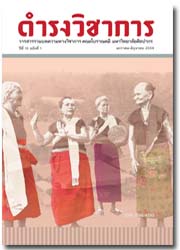PHI TA KHON PERFORMING GANGNAM STYLE DANCE: A CASE STUDY OF THE IMPACT OF TOURISM INDUSTRY ON THE CHANGING CULTURAL MEANING.
Keywords:
Phi Ta Khon, impacts of tourism, cultural meaning and representation, narrative, intertextual worldlinessAbstract
This article presents a case study of the impact of tourism industry on host community. A textual analysis of the narrative elements of the video clip “ผีตาโขนเต้นกังนัมสไตล์” (Phi Ta Khon Performing Gangnam Style Dance) produced by the Dansai Municipality is employed to unpack the meaning-making process that generates the new meaning of “being touristy” to the Phi Ta Khon tradition of Dansai, Loei Province, which is different from the definition made by the Dansai residents. The textual analysis also renders comprehensible the conflict between the municipality and the residents caused by their different meaning-making approaches. While the Phi Ta Khon tradition is seen by the municipality as a “culture for sale,” to the residents of Dansai, its cultural significance is the result of the combined socio-historical contexts of Dansai. The municipality’s clip production without consulting the residents reveals the local government’s intervention which subsequently leads to the conflict between the authorities and the community.
References
Barthes R., 1972. Mythologies. (Translated by J. Cape). New York: The Noonday Press.
Hobsbawm E., 1992. “Introduction: Inventing Tradition.” In E. Hobsbawm & T. Ranger (eds.), The Invention of Tradition (pp. 1-14). Cambridge: Cambridge University Press.
Said E., 1983. The World, the Text, and the Critic. Cambridge, Massachusetts: Harvard University Press.
Storey J., 2003. Inventing Popular Culture: From Folklore to Globalization. Oxford: Blackwell.
Urry J. & Larsen J., 2011. The Tourist Gaze 3.0. London: Sage.
Obpahat J., 2010. Development Strategies in the Crafting of Phi Ta Khon Masks in the Dansai Community, Loei Province. Doctoral dissertation. Faculty of Educaiton, Rajabhat Rajanagarindra University, Chachoengsao.
Phungpracha E., 2005. “Phi Ta Khon: Identification and Meaning Behind the Head-mask.” Damrong Journal 4 (1): 110-9.
Phungpracha E., 2013. “Socio-Cultural Structure of Phi Ta Khon.” Muang Boran 39 (4): 106-18.
Pornpenpipat C., 2003. Phi Ta Khon: Moradok Phaendin Srisongrak [Phi Ta Khon: The Heritage of Srisongrak]. Bangkok, Thailand: Ton Or 1999.
Soongsiri W. & Wangwiwatsin N. (eds.), 2007. Phi Ta Khon: Enjoyable Boon Luang Day. Dansai District, Loei, Thailand: Dansai Crown Prince Hospital.
Suanpradit K., 1990. Phi Ta Khon: A Case Study of Amphoe Dan Sai, Changwat Loei. Master’s dissertation. Srinakharinwirot University Mahasarakham, Mahasarakham.
Thailand Research Fund, 2007. Phi Kap Phut: Satsana Lae Khwam Chuea Nai Sangkhom Dansai, Dunyaphap Nai Chitwinyan Khong Chaoban Nai Lummaenam Man [Ghosts and Buddhism: Religion and Beliefs in the Dansai Society, Spiritual Balance of the Villagers along the Man River Basin]. Bangkok, Thailand: Lek-Prapai Organization.
Upala S., 2003. The Development of Phi Ta Khon Festival at Amphoe Dan Sai, Changwat Loei. Master’s dissertation. Graduate School of Rajabhat Institute Loei, Loei.
Sritraipop B., 2012. Ghost Festival-themed ‘Gangnam Style’ video offends Loei villagers. The Nation, November 9. Retrieved March 6, 2016, from http://www.nationmultimedia.com/national/Ghost-Festival-thrmrd-Gangnam-Style-video-offends--30193988.html
TakumiA31. 2012. “ผีตาโขนเต้นกังนัมสไตล์.” YouTube video. Retrieved March 4, 2016, from https://www.youtube.com/watch?v=pZ_liSRlTP8
TAT Newsroom. Tourism Authority of Thailand: Mission. Retrieved April 1, 2016, from http://www.tatnews.org/mission/
United Nations Environment Programme. Negative Socio-Cultural Impacts From Tourism: Change or loss of indigenous identity and values. Retrieved April 1, 2016, from http://www.unep.org/resourceefficiency/Business/SectoralActivities/Tourism/FactsandFiguresaboutTourism/ImpactsofTourism/Socio-CulturalImpacts/NegativeSocio-CulturalImpactsFromTourism/tabid/78781/Default.aspx
Downloads
Published
Issue
Section
License
บทความนี้เป็นผลงานของข้าพเจ้าแต่เพียงผู้เดียว และ/หรือเป็นผลงานของข้าพเจ้าและผู้ร่วมงาน ตามชื่อที่ระบุในบทความจริง และเป็นผลงานที่มิได้ถูกนำเสนอหรือตีพิมพ์ที่ใดมาก่อน





